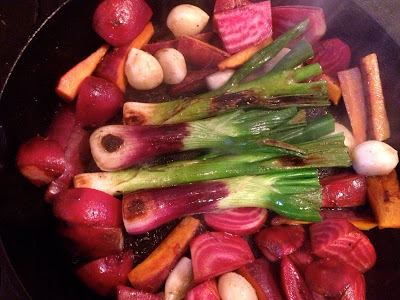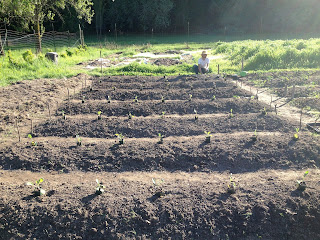We are looking forward to having these vegetables in the upcoming CSA boxes! One of the things about preparing for the CSA box for the week is to try out the vegetables that are just starting to come on board and that are ready to be picked. The scallions are ready to be picked and the radicchio have been waiting for their turn as well. As the farmers, we have to try things out ahead of time to be sure they are ready, while at the same time we often bring home the vegetables that are past their prime or have some "imperfections" or in the case of the carrots were not "the perfect carrot". So in this meal, we had some carrots that lost their tops and so don't look "carrot perfect" for a box, some broccoli that was left a little too long on the plant and was starting to flower (although the flowering broccoli is still very tasty and pretty) and the radicchio were plants I had pulled out the day before and left on a pile of radicchio leaves next to the bed to give some room to some other radicchio they were crowding and I pulled away all the icky leaves surrounding them to reveal perfectly good small heads of radicchio below! I couldn't let them go to waste and so they became a part of this meal.
The Ingredients:
From left to right here's what we had in this meal.
carrots - Cosmic Purple
radicchio - Palla Rossa
scallions - Deep Purple and Welsh
garlic - California Early
broccoli - Green Sprouting (and partially flowering)
beets - Chioggia
greens - beet tops, basil Genovese, kale Lacinato
also:
olive oil
salt
lemon
Begin by chopping the bigger and firmer vegetables to be roasted. Here we have the broccoli, carrots, beets, scallions, and garlic. The garlic was peeled, but left whole. I peeled at least 5 cloves. The scallions had their tops removed and reserved for the pesto. The same with the beet greens.
I do a variation of my Dad's 3x cooked vegetables by doing a 2x cooked and eliminating the 2 minute boil for this dish and starting with a quick browning. I start with a very hot cast iron skillet and add olive oil (a very generous helping of olive oil!)
Brown all sides of the vegetables in olive oil.
I took those vegetables out of the cast iron after they were browned and placed them on my preheating pan in my oven. I cook at 400 deg F.
I then tossed my broccoli into the hot cast iron and browned that for a couple of minutes before removing it and adding the broccoli to the pan in the oven.
Placed them face down on the cast iron and let them sizzle for a couple of minutes
Then carefully flipped them, so that they didn't fall apart and browned the other side.
Then added the radicchio to the pan in the oven. By now the carrots, beets, scallions, and onions have been roasting the longest and should be starting to get nice and caramelized. I then added some salt to the roasting vegetables before closing the oven and turning my attention to the pesto ingredients.
The Pesto:
scallion tops
kale leaves
beet greens
basil
garlic cloves
lemon
salt
olive oil
I began by using my mezzaluna to chop up the garlic first. I chopped the cloves just enough so that they would get chopped smaller and smaller as I added each green.
Next I added the scallion tops and chopped those just a little.
Then the kale and chopped just a little
Then the beet greens and chopped just a little. I then added my healthy drizzle of olive oil, dashed on plenty of salt, and squeezed half a lemon.
And then begins the project of using whatever chopping device you have on hand (I sure do love my cheap, $5, found on a bottom shelf, discounted mezzaluna for fine chopping) and chopping to desired fineness all the pesto ingredients by mixing and chopping, mixing and chopping.
Once the pesto is finely chopped, it is time to turn off the oven and begin to put together the meal.
The Meal:
The roasted vegetables were divided up and carefully placed in our bowls, the center was topped with a generous helping of pesto, crusty bread was sliced and toasted, our dipping sauce was even more olive oil (we sure do love it) with some spicy roasted pepper salt. We paired it with our 2nd bottle of Torrontes (the $0.5 bottle) and sat down to finally enjoy the evening. And even though the vegetables we took home to make dinner were not up to our standards for a CSA box, they still turned into a delicious meal.
p.s.
As I mentioned, the next night we still had leftover roasted vegetables and pesto. I tossed some more chopped veggies into a big soup pot, browned them a bit, added lots of water and the right amount of salt, let that simmer and then added the shell pasta and the rest of the roasted veggies and the pesto and let it all simmer for 10 minutes. That lasted us two extra days! I love meals like that that have many facets and that allow us to have a break from making dinner every night (or at least me from having to make dinner every night!) especially when we are so busy with our farm and work.
Enjoy!







































